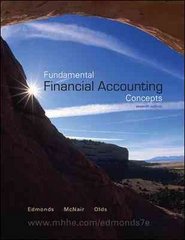The following transactions apply to Sharp Consulting for 2011, the first year of operation: 1. Recognized ($
Question:
The following transactions apply to Sharp Consulting for 2011, the first year of operation:
1. Recognized \(\$ 65,000\) of service revenue earned on account.
2. Collected \(\$ 58,000\) from accounts receivable.
3. Adjusted accounts to recognize uncollectible accounts expense. Sharp uses the allowance method of accounting for uncollectible accounts and estimates that uncollectible accounts expense will be 2 percent of sales on account.
The following transactions apply to Sharp Consulting for 2012:
1. Recognized \(\$ 72,500\) of service revenue on account.
2. Collected \(\$ 66,000\) from accounts receivable.
3. Determined that \(\$ 900\) of the accounts receivable were uncollectible and wrote them off.
4. Collected \(\$ 100\) of an account that had been previously written off.
5. Paid \(\$ 48,500\) cash for operating expenses.
6. Adjusted accounts to recognize uncollectible accounts expense for 2012. Sharp estimates that uncollectible accounts expense will be 1 percent of sales on account.
Required
Complete all the following requirements for 2011 and 2012. Complete all requirements for 2011 prior to beginning the requirements for 2012.
a. Identify the type of each transaction (asset source, asset use, asset exchange, or claims exchange).
b. Show the effect of each transaction on the elements of the financial statements, using a horizontal statements model like the one shown here. Use + for increase, - for decrease, and NA for not affected. Also, in the Cash Flow column, indicate whether the item is an operating activity (OA), investing activity (IA), or financing activity (FA). The first transaction is entered as an example. (Closing entries do not affect the statements model.)

c. Record the transactions in general journal form, and post them to T-accounts (begin 2012 with the ending \(\mathrm{T}\)-account balances from 2011).
d. Prepare the income statement, statement of changes in stockholders' equity, balance sheet, and statement of cash flows.
e. Prepare closing entries and post these closing entries to the T-accounts. Prepare a post-closing trial balance.
Step by Step Answer:






